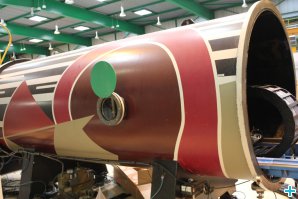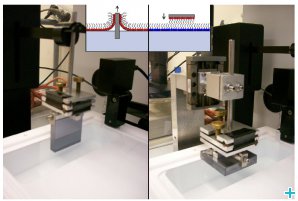Update on the advanced neutron tools for soft and bio-materials JRA
Annie Brûlet, the coordinator of this JRA, told Inês Crespo about this collaboration’s main goals and achievements.
08/01/2014
Annie Brûlet is the head of the Large Scale Structure group at the Laboratoire Léon Brillouin (LLB) in France and the coordinator of the NMI3 Joint Research Activity (JRA) on Advanced neutron tools for soft and bio-materials . On the occasion of the last JRA meeting at the Heinz Maier-Leibnitz Zentrum (MLZ) in November 27 and 28 2013, she met the NMI3 Information Manager, Inês Crespo, and explained her all about the work conducted within this JRA, recent achievements and the biggest challenges.
What soft and bio materials are and why to investigate them
Soft materials comprise polymers, colloidal particles, soaps, surfactants, and such. They display rather disordered structures, as opposed to organised hard materials such as most metals and alloys. Bio materials, which include for instance lipids, peptides, proteins, sugar, and DNA, display similar structures and properties. All these materials deserve to be studied because they are important in the fields of environment, energy, and medicine. Due to the length and time scales investigated, neutron scattering is a unique tool to determine the structure and the dynamics of these complex soft materials: SANS, reflectometry, and spin-echo are widely used methods to study them. A large number of scientists work on soft and bio materials and each neutron facility develops its own sample environment. This translates to a myriad of devices currently in use, a number of which would benefit from further investigation.
Directors of European neutron facilities have therefore decided to join efforts in an NMI3 Joint Research Activity (JRA) to provide a wider range of experimental tools enabling to make the best use of neutron scattering for soft and bio-materials studies. Their main aim is two-fold:
- to create a platform for model bio-membranes, and
- to develop new sample environments for soft and bio materials, and improve existing equipments.
A platform for model biological membranes
The neutron scattering techniques currently used to study biological membranes are reflectometry and Small Angle Neutron Scattering (SANS) associated to labelling. These are now mature techniques, which allow to analyse membranes in detail. However, natural membranes are difficult to study due to their complexity, so it is necessary to create model membranes to mimic them while including deuterated molecules, like for example lipids. All the facilities therefore agreed to contribute to the development of a platform for model bio membranes. This task is coordinated by Giovanna Fragneto from the Institute Laue-Langevin (ILL) in France (for further information you can read our interview with her ).
Since the beginning of the project in 2012, this JRA has taken an important step in the development of a floating bilayer model. In order to produce a good model membrane, two membranes are placed on the top of each other, the first membrane being “attached” to a substrate, like for instance a silicon wafer. Both ILL and ISIS (STFC in England) groups have developed new methods that enable to have a full coverage of the substrate by the first membrane, so that it will be easier to create a subsequent membrane with a very well defined structure to study by reflectometry.
Another aim of this task is also in an advanced stage. Given that bio membranes are complex, scientists are using deuterated molecules or labelled solvents in order to focus on one given component of the complex membrane. The aim of the JRA is to create “recipes” to extract natural lipids including deuterated ones from the biomass. The ILL group is growing labelled molecules in the deuteration lab in Grenoble, to later extract the lipids and incorporate them in the model membranes. They have already succeeded to extract deuterated lipids from natural yeast. This work is extremely important for the European facilities and their users because deuterated lipids are not available in the market and can thus be provided.
An improved sample environment suite
The properties of soft and bio materials are sensitive to many stimuli: changes of temperature, pH, pressure, shearing and deformation, magnetic field, UV irradiation, etc. Many sample environments are available for in situ neutron scattering experiments. One issue for the applications of soft and bio materials is to tune them to the right length and properties in order to recognise a certain target (e.g. a tumour) and make them sensitive to an external parameter, such as temperature, magnetic field, or other. One example of application currently under test is a novel way for drug delivery using diblock copolymer vesicles with loaded magnetic nanoparticles located inside the membrane: the local heating produced by the relaxation of the magnetic particles submitted to a DC magnetic field is changing the local structure of the membrane and makes it explode to deliver the encapsulated drug.

Small Angle Neutron Scattering (SANS) detector tube of PAXY (Petit Angle XY) instrument at LLB, used by Annie Brûlet to test the new sample environments for SANS
This JRA is focusing on a few devices only, like a pressure cell for SANS and later on for neutron spin echo, an improved stop flow device, a cryostat without cryogenics but with sample changer, a new humidity chamber, and others. Annie Brûlet is involved in a task to develop a new electric field cell, in which the electrodes are placed outside the sample rather than inside. This alternative method aims to avoid the solvent electrolysis. The sample is therefore placed between two electrodes to which a voltage is applied, making it possible to investigate for instance whether the particles are aligned and if structural changes occur. The main challenge of this process is to determine the effective electric field applied to the sample and optimise the device even for high permeability solutions. A colleague from this JRA at LLB has already developed a prototype and the objective is to provide guide elements for the value of the electric field applied to the sample. This work will offer a new sample environment to users.
An NMI3’s joint research activity
The groups who participate in this collaboration come from six different institutes based in three different countries, and therefore it is not easy to meet often to actually work together, so video conferences are sometimes used. Nevertheless, everyone involved is highly professional, willing to share information and experiences, which certainly makes coordination smoother for Annie Brûlet. The collaboration between engineers, technicians and researchers of the different facilities is more efficient when equipments are shared too. For instance, for the task of the pressure cell for SANS, tests have been performed by scientists both at LLB in France and at the Jülich Centre for Neutron Science (JCNS) in Germany in order to compare and gain experience in two different systems. Then further discussions with the other partner of the task, ILL, led to take rapid decisions concerning future work.
Another peculiarly good example of collaboration concerns the task to build a new humidity chamber with temperature and humidity ratio control of the sample. Groups from ILL and the Helmholtz-Zentrum Berlin (HZB) (who coordinates the task) are in close contact with Matthew Barrett, a PhD student from HZB dedicated exclusively to this work, to develop a new and very efficient system. An advanced design of the future humidity chamber has been presented at the ICNS conference in Edinburgh in July 2013 for which he won a poster prize.
This JRA is on the right path to achieve the goals proposed by the end of NMI3-II, and everyone involved is taking the opportunity to learn new techniques used in the participating facilities. The results obtained so far are proof of this successful collaboration!
JRA partners
Useful links
NMI3 thanks Annie Brûlet for reviewing this article.

